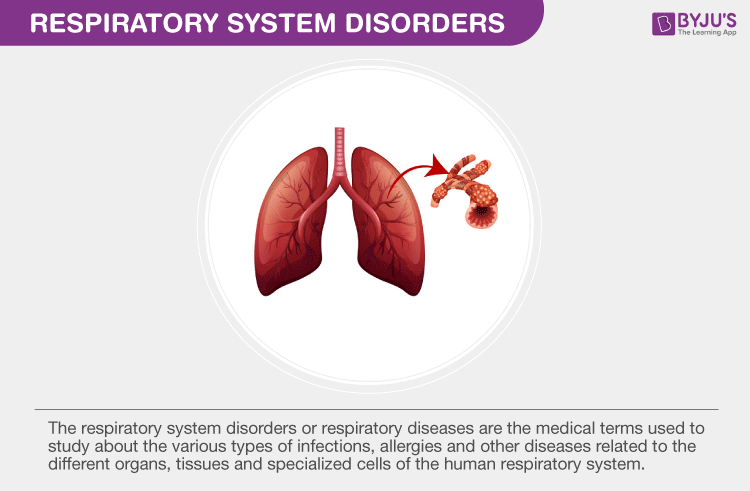Table of Contents
- What are Respiratory System Disorders?
- Factors Affecting Respiratory System Disorders
- Types of Respiratory System Disorders
- Causes of Respiratory Disorders
- Respiratory Diseases
What are Respiratory System Disorders?
“Respiratory disorders or diseases are diseases of lungs and human airways that affect human respiration.”
A disorder is defined as a state of irregular functioning of the body. Respiratory system disorders or respiratory diseases are the medical terms used to study the various types of infections, allergies and other diseases related to the different organs, tissues and specialized cells of the human respiratory system.
The respiratory system mainly consists of the upper respiratory tract, alveoli, bronchi, bronchioles, trachea, pleura, and pleural cavity. The common cold is an example of a mild respiratory disorder and other serious and life-threatening respiratory disorders include pneumonia, lung cancer and asthma, influenza, tuberculosis, etc.

Factors Affecting Respiratory System Disorders
There are several factors associated with respiratory system disorders. A few of these factors include:
- Genetics
- Allergies
- Smoking
- Air Pollution
- Bacterial and viral infections.
Types of Respiratory System Disorders
Respiratory system disorders affect millions of people worldwide. There are three main types of respiratory diseases:
Airway Disease
It affects the bronchial tubes which function by transporting oxygen and other gases in and out of the lungs. In airway disease, the passage for air is reduced, which is associated either with narrowing or blocking of bronchial tubes.
Lung Tissue Disease
Human lungs are covered by a thin tissue layer called the pleura. Due to certain viral or bacterial infections, the structure of the lung tissues is affected, which results in scarring or inflammation of the tissue that enables the lungs to expand normally and in turn, makes breathing difficult.
Lung Circulation Disease
This disorder occurs when the blood vessels of the lungs are coagulated, swollen or damaged. This affects the ability of the lungs to receive oxygen and release carbon dioxide. In extreme cases, this disorder may affect the functioning of the heart.
Also Read: Respiration
Causes of Respiratory Disorders
Respiratory diseases are caused due to exposure to pollutants, smoking, passively inhaling tobacco smoke, asbestos, radon, etc.
Respiratory Diseases
Following are the major respiratory disorders or diseases:
Asthma
Asthma is a chronic disease which affects the bronchi and bronchioles of the lungs. It causes difficulty in breathing and is followed by severe cough, restlessness, cough and a wheezing sound while breathing.
Asthma might cause due to the following factors:
- Cold air
- Airborne allergens
- Respiratory infections
- Physical activity
- Air pollutants
Chronic Obstructive Pulmonary Disease (COPD)
This includes all the respiratory diseases that cause breathlessness or the inability to exhale. It largely affects people who have been exposed to some sort of smoke. It is a very serious disease and worsens even if you stop smoking.
Emphysema
Emphysema is defined as a chronic disease, reduction of the respiratory surface due to damage to the lung alveolar walls. It is caused mainly by cigarette smoking. The main symptoms of emphysema include shortness of breath and cough. Emphysema might lead to a loss of elasticity of the lungs.
Emphysema may be caused by the following factors:
- Dust
- Chemicals
- Air pollution
- Smoking tobacco
- Exposure to passive cigarette smoking
Occupational Respiratory Disorders
Occupational respiratory disorders are defined as any disorder which affects the respiratory system by long-term inhalation of chemicals, proteins, and dust. For instance, Asbestosis is caused by the inhalation of asbestos dust.
Occupational respiratory disorders might happen due to the inhalation of the following substances:
- Fumes from metals.
- Smoke from burning organic materials.
- Sprays of varnish, paint, acids, and pesticides.
- Dust from cotton, silica, coal, drug powders and pesticides.
- Gases from industries. For instance, Ammonia, chlorine and nitrogen oxides.
Sinusitis
It is the inflammation of the mucous membranes in the nasal sinus. The mucous membranes produce mucus that drains into the nasal cavities. Bacterial or viral infections or some airborne allergens cause the inflammation of the mucous membranes.
Lung Cancer
Lung cancer can develop in any part of the lungs. It occurs in the main part of the lungs. The treatment of lung cancer depends upon the type, location and its spread.
Also Read: Cellular Respiration
For more additional information about respiratory system disorders and their types and causes, keep visiting BYJU’S website.

Awesome!
wonderful